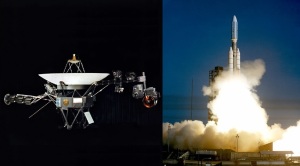Voyager 1 has marked one of the most significant technological achievements in the annals of the history of science. It is currently where no probe has gone before.
It is a 722 kg spacecraft launched by NASA on 5 Sept 1977 to study the outer Solar System. Currently it is the farthest manmade object from Earth.
Its main objective (to look at Jupiter, Saturn, Uranus and Neptune) was completed in 1989. Afterwards it continued flying toward the edge of the heliosphere and it was not until 25 August 2012 when it entered interstellar space (confirmed by NASA 12 September 2013)
The radio communication system of Voyager 1 was designed to be used beyond the limits of the Solar System. It is composed by a 3.7 meters diameter parabolic dish high-gain antenna to send and receive radio waves via the three Deep Space Network stations on the Earth. Downlink frequency is 2296.481481 MHz or 8420.432097 MHz (Deep Space Network Channel 18), while uplink signals from Earth to Voyager are broadcast at 2114.676697 MHz
In case Voyager 1 is found by intelligent life forms from other planetary systems, it carries a disc with photos, “sounds of Earth” (baby crying, whale or wave sound, etc.) and music. Voyager 1 is currently 17 light-hours away from the Earth and moving at a speed of 61,000 km/h relative to the Sun. The probe is expected to continue its mission until 2025, when its generators will not have enough power to operate any of its instruments.

